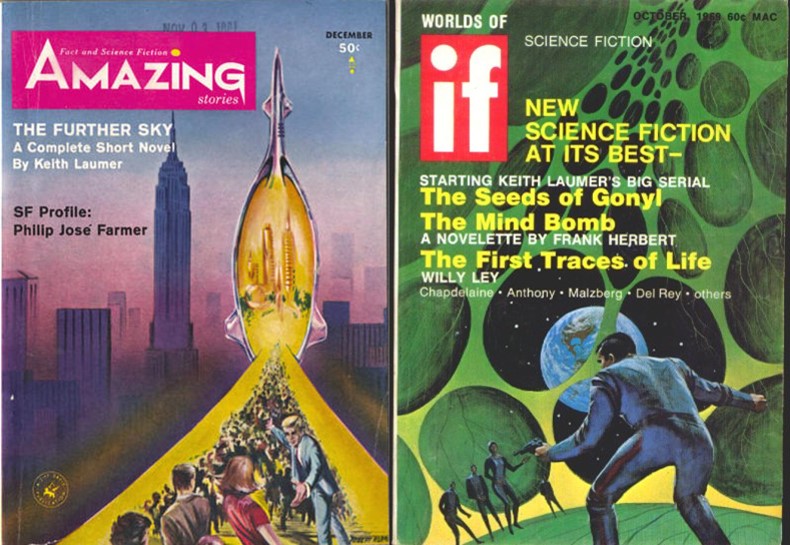Tor Doubles: #0: Keith Laumer’s The Other Sky and The House in November

The House in November cover by Mike Embden
Between October and December of 1969, Keith Laumer’s novella The Seeds of Gonyl were published as a serial in the magazine Worlds of If. The story was published the following year in a hardcover by G.P. Putnam & Sons under the title The House in November, and in 1971 as a paperback by Berkley Medallion.
In 1981, Tor reprinted the novel as part of its “Jim Baen Presents” series, but, apparently deeming the novel too short, it paired it with Laumer’s story “The Further Sky,” which had originally be published in the December 1964 issue of Amazing Stories. That story had also undergone a name change and appeared as “The Other Sky” in various reprints, including its appearance with The House in November.
When Tor Books reprinted the volume in 1985, they included a shield on the cover identifying the book as a “Tor Double.” This book may possibly have been created as a dry run or proof of concept for the eventual Tor Double line. The cover for The Other Sky was provided by Thomas Kidd and the cover for The House in November was provided by Mike Embden, although their credits are reversed on the copyright pages.
“The Other Sky” opens with Vallant having a run-in with the Niss, an alien race that is working in collaboration with humans, although immediately after, he finds an old man in his apartment. The stranger not only claims to have been one of Vallant’s comrades several years earlier (although Vallant has no memory of the man or the situation he describes), but also warns Vallant against the Niss before disappearing through a secret panel in Vallant’s apartment.
When Vallant tries to follow the old man, who discovers he has been killed by the Niss, but he also finds himself taking responsibility for Jimper, an intelligent creature. Jimper confirms what the old man had told Vallant about the Niss, but takes it a step further, claiming to be an ambassador from the King of Galliale to the Humans to form an alliance against the Niss.
Vallant and Jimper flee and find themselves among Jimper’s people on Pluto, although Jimper is not greeted in the manner in which he expects. Although neither Vallant or Jimper understand what is happening, either with the humans, the Niss, or the Gaillialans, Laumer has left enough clues that the reader has a pretty good idea what must happen for all of the pieces to come together. The addition of a portal to another world only helps seal the deal.
However, the quick sequential scenes don’t allow Laumer to fully build the characters or their situations, giving “The Other Sky” the feeling of an outline for a longer work, which means the story is ultimately disappointing and unsuccessful.
For a modern reader, Jimper’s manner of speaking in the third person has the same cadences as J.K. Rowling’s house-elf, Dobby, which bring images to mind as the novel progresses which may not be fair or accurate to Laumer’s portrayal.

Worlds of If cover by Jack Gaughan
The House in November follows Jeff Mallory through a post-war Nebraskan landscape, although the nature of the war is ill defined. At the beginning of the novel, Mallory is awaking from a fugue state. Although he has memories of working in the Miller Building, his wife, Gillian, insists they both work in the Star Tower. In addition, Gillian has no recollection of their oldest child, Lori, or a house in the country where they have spent their time. Leaving he house, he discovers that everyone in town seems to live in the same alternative world Gillian exists in and he flees into the countryside.
As he travels, Jeff discovers that there has been some kind of invasion which has depopulated most of the United States. He comes across small bands of refugees, most of whom are not hospitable t a stranger, although along his travels he connects with Sally, one of his daughter Lori’s friends, and they travel together, eventually finding an ersatz army but together by Colonel Strang. Lori appears to be supporting Strang’s army, and Jeff finds himself impressed into service.
Strang is convinced that the Chinese have invaded the United States and set up their base in Beatrice, the town where Jeff has been living. Nothing Jeff can say will make Strang believe that there are Americans still living in Beatrice and there are no Chinese. Eventually going AWOL, Jeff finds others who are convinced the invasion is from Satanic minions. Jeff is positive the invasion is by aliens, based on what he saw in Beatrice before he left. Although Laumer could have played up Jeff’s paranoia, making the reader question Jeff’s conclusions, The House in November is written in a way that makes the reader side with Jeff against any other theories, all of them as bereft of evidence as any of the others.
Eventually, Jeff does learn what is going on and the reader discovers that for all his normalcy, Jeff is not a normal person. He is, in many ways, the Chosen One, which may ultimately allow him to break through the haze that has settled on so many people and show them the truth of the situation, and possibly even find a solution.
Much of The House in November is episodic in nature and Laumer doesn’t spend too much time exploring any of the episodes. He gets out of Beatrice as quickly as possible at the beginning of the book. The scene in which he finds Sally living with a few survivors is over almost as soon as it starts. His encounter with Colonel Strang’s army, including Lori, exists to give him an idea of how different people’s ideas are, but he quickly leaves them behind and manages to avoid capture by Strang’s forces looking for him. Other scenes are similarly brief, which gives the story a rushed and unfinished feel, as if any of these sequences, or characters, could and should have been fleshed out more than they were.
The novella only finds its pacing when Jeff arrives at the titular house and comes into contact with Gonyl, who may be able to provide him with the answers he seeks. Having set up the world, Laumer is now able to explain to Jeff and to the reader what is happening and why Jeff was able to come out of the stupor in which he found himself.
Both stories in this volume suffer from pacing issue, both of them almost feeling as if they are outlines for more detailed novels. Laumer has elected to include several short scenes which hint at the larger concern, failing to fully flesh them out and never quite connecting with the readers, who never really had a chance to immerse themselves in the action. Both stories are tales of invasion by alien forces which are not fully understood by the people who have fallen under the alien’s control.
 Steven H Silver is a twenty-one-time Hugo Award nominee and was the publisher of the Hugo-nominated fanzine Argentus as well as the editor and publisher of ISFiC Press for eight years. He has also edited books for DAW, NESFA Press, and ZNB. His most recent anthology is Alternate Peace and his novel After Hastings was published in 2020. Steven has chaired the first Midwest Construction, Windycon three times, and the SFWA Nebula Conference numerous times. He was programming chair for Chicon 2000 and Vice Chair of Chicon 7.
Steven H Silver is a twenty-one-time Hugo Award nominee and was the publisher of the Hugo-nominated fanzine Argentus as well as the editor and publisher of ISFiC Press for eight years. He has also edited books for DAW, NESFA Press, and ZNB. His most recent anthology is Alternate Peace and his novel After Hastings was published in 2020. Steven has chaired the first Midwest Construction, Windycon three times, and the SFWA Nebula Conference numerous times. He was programming chair for Chicon 2000 and Vice Chair of Chicon 7.
Gee, the designs of the book’s covers makes me think of Baen Books, certainly. Not hard to see how “Jim Baen Presents” was the imprint, at least at the start of the Tor Doubles.
I haven’t read The House In November but I did read “The Furthest Sky” in that December 1964 issue of Amazing, and my reaction is pretty similar to yours. As it put it in my Retro Review of the issue, here at Black Gate:
“Laumer’s novella is curious and rather a mess. It’s a Niss story, though to my taste it doesn’t mesh well with the other Niss stories I’ve read. It concerns Amory Vallant, who meets an old man who claims to know him on Niss-dominated Earth, and further claims to have known Amory when he was in the Navy — but Amory has never been in the Navy. Before long Vallant has encountered Jimper, a tiny humanoid who tells him of his land on Pluto. Vallant is confused but before long is forced to kill a Niss, and he and Jimper end up on the run, head for Pluto and Galliale and a strange mystery. It’s obvious that time travel is involved, and Laumer sets that aspect up reasonably well, but on the whole the story is too implausibly convoluted to really hold together.”
“Seeds of Gonyl” sounded familiar. Turns out I reviewed part of it back in my November 1969 cadre of SF magazines in Worlds of If.
https://www.blackgate.com/2018/01/23/worlds-of-if-november-1969-a-retro-review/